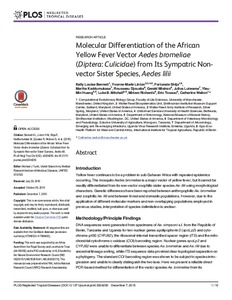| dc.contributor.author | Bennett, K.L. |
| dc.contributor.author | Linton, Y. |
| dc.contributor.author | Shija, F. |
| dc.contributor.author | Kaddumukasa, M. |
| dc.contributor.author | Djouaka, R.F. |
| dc.contributor.author | Misinzo, G. |
| dc.contributor.author | Lutwama, J. |
| dc.contributor.author | Huang, Y. |
| dc.contributor.author | Mitchell, L.B. |
| dc.contributor.author | Richards, Meryl |
| dc.contributor.author | Tossou, E. |
| dc.contributor.author | Walton, C. |
| dc.date.accessioned | 2019-12-04T11:03:39Z |
| dc.date.available | 2019-12-04T11:03:39Z |
| dc.date.issued | 2015-12-07 |
| dc.identifier.citation | Bennett, K.L., Linton, Y.M., Shija, F., Kaddumukasa, M., Djouaka, R., Misinzo, G., ... & Tossou, E. (2015). Molecular differentiation of the African yellow fever vector Aedes bromeliae (Diptera: Culicidae) from its sympatric non-vector sister species, Aedes lilii. PLoS Negl Trop Dis, 9(12), e0004250. |
| dc.identifier.issn | 1935-2735 |
| dc.identifier.uri | https://hdl.handle.net/20.500.12478/1183 |
| dc.description.abstract | Introduction
Yellow fever continues to be a problem in sub-Saharan Africa with repeated epidemics occurring. The mosquito Aedes bromeliae is a major vector of yellow fever, but it cannot be readily differentiated from its non-vector zoophilic sister species Ae. lilii using morphological characters. Genetic differences have been reported between anthropophilic Ae. bromeliae and zoophilic Ae. lilii and between forest and domestic populations. However, due to the application of different molecular markers and non-overlapping populations employed in previous studies, interpretation of species delimitation is unclear.
Methodology/Principle Findings
DNA sequences were generated from specimens of Ae. simpsoni s.l. from the Republic of Benin, Tanzania and Uganda for two nuclear genes apolipophorin 2 (apoLp2) and cytochrome p450 (CYPJ92), the ribosomal internal transcribed spacer region (ITS) and the mitochondrial cytochrome c oxidase (COI) barcoding region. Nuclear genes apoLp2 and CYPJ92 were unable to differentiate between species Ae. bromeliae and Ae. lilii due to ancestral lineage sorting, while ITS sequence data provided clear topological separation on a phylogeny. The standard COI barcoding region was shown to be subject to species introgression and unable to clearly distinguish the two taxa. Here we present a reliable direct PCR-based method for differentiation of the vector species Ae. bromeliae from itsisomorphic, sympatric and non-biomedically important sister taxon, Ae. lilii, based on the ITS region. Using molecular species verification, we describe novel immature habitats for Ae. lilii and report both sympatric and allopatric populations. Whereas only Ae. lilii is found in the Republic of Benin and only Ae. bromeliae in Tanzania, both species are sympatric in Uganda.
Conclusions/Significance
Our accurate identification method will allow informed distribution and detailed ecological studies that will facilitate assessment of arboviral disease risk and development of future targeted vector control. |
| dc.format.extent | 1-19 |
| dc.language.iso | en |
| dc.subject | Dna |
| dc.subject | Ribosomal |
| dc.subject | Phylogeny |
| dc.subject | Vector |
| dc.title | Molecular differentiation of the African yellow fever vector Aedes bromeliae (Diptera: Culicidae) from its sympatric nonvector sister species, Aedes lilii |
| dc.type | Journal Article |
| dc.description.version | Peer Review |
| cg.contributor.affiliation | University of Manchester |
| cg.contributor.affiliation | Smithsonian Institution Museum Support Center |
| cg.contributor.affiliation | Uniformed Services University of Health Sciences |
| cg.contributor.affiliation | Smithsonian Institution |
| cg.contributor.affiliation | Sokoine University of Agriculture |
| cg.contributor.affiliation | Uganda Virus Research Institute |
| cg.contributor.affiliation | International Institute of Tropical Agriculture |
| cg.coverage.region | Africa |
| cg.coverage.region | East Africa |
| cg.coverage.region | West Africa |
| cg.coverage.country | Benin |
| cg.coverage.country | Tanzania |
| cg.coverage.country | Uganda |
| cg.isijournal | ISI Journal |
| cg.authorship.types | CGIAR and developing country institute |
| cg.authorship.types | CGIAR and advanced research institute |
| cg.iitasubject | Disease Control |
| cg.journal | PLOS Neglected Tropical Diseases |
| cg.howpublished | Formally Published |
| cg.accessibilitystatus | Open Access |
| local.dspaceid | 78377 |
| cg.targetaudience | Scientists |
| cg.identifier.doi | https://dx.doi.org/10.1371/journal.pntd.0004250 |

